Polyvinyl Acetate Binders Undermine the Effectiveness of Biochar-Based Seed Coatings
Abstract
1. Introduction
2. Materials and Methods
2.1. Experimental Species
2.2. Biochar Encapsulation of Seeds
2.3. Experimental Design
2.3.1. Petri-Dish Experiments
2.3.2. Greenhouse Experiments
2.4. Seedling Performance and Growth Measurements
2.5. Physiological Measurements
2.6. Statistical Analysis of Experimental Results
2.7. Meta-Analysis
3. Results
3.1. Petri Dish Experiments
3.1.1. Germination and Early Seedling Growth
3.1.2. PVAc Effects on Germination
3.2. Greenhouse Experiments
3.2.1. Biomass Responses
3.2.2. Chlorophyll Content and Fluorescence
3.2.3. Meta-Analysis of PVAc Effects on Germination of Biochar-Coated Seed
4. Discussion
4.1. Effects of Biochar-Based Seed Coatings
4.2. Biochar-Based Seed Coatings and Salinity Mitigation
5. Conclusions
Supplementary Materials
Author Contributions
Funding
Data Availability Statement
Acknowledgments
Conflicts of Interest
References
- Nachshon, U. Cropland soil salinization and associated hydrology: Trends, processes and examples. Water 2018, 10, 1030. [Google Scholar] [CrossRef]
- Cunningham, M.A.; Snyder, E.; Yonkin, D.; Ross, M.; Elsen, T. Accumulation of deicing salts in soils in an urban environment. Urban Ecosys. 2008, 11, 17–31. [Google Scholar] [CrossRef]
- Equiza, M.A.; Calvo-Polanco, M.; Cirelli, D.; Señorans, J.; Wartenbe, M.; Saunders, C.; Zwiazek, J.J. Long-term impact of road salt (NaCl) on soil and urban trees in Edmonton, Canada. Urban For. Urban Green. 2017, 21, 16–28. [Google Scholar] [CrossRef]
- Mendez, M.O.; Maier, R.M. Phytostabilization of mine tailings in arid and semiarid environments—An emerging remediation technology. Environ. Health Perspect. 2008, 116, 278–283. [Google Scholar] [CrossRef] [PubMed]
- Dumbroff, E.B.; Cooper, A.W. Effects of salt stress applied in balanced nutrient solutions at several stages during growth of tomato. Botan. Gaz. 1974, 135, 219–224. [Google Scholar] [CrossRef]
- Lutts, S.; Kinet, J.M.; Bouharmont, J. Changes in plant response to NaCl during development of rice (Oryza sativa L.) varieties differing in salinity resistance. J. Exper. Bot. 1995, 46, 1843–1852. [Google Scholar] [CrossRef]
- Qadir, M.; Oster, J.D. Crop and irrigation management strategies for saline-sodic soils and waters aimed at environmentally sustainable agriculture. Sci. Total Environ. 2004, 323, 1–19. [Google Scholar] [CrossRef]
- Leogrande, R.; Vitti, C. Use of organic amendments to reclaim saline and sodic soils: A review. Arid Land Res. Manag. 2019, 33, 1–21. [Google Scholar] [CrossRef]
- Thomas, S.C.; Frye, S.; Gale, N.; Garmon, M.; Launchbury, R.; Machado, N.; Melamed, S.; Murray, J.; Petroff, A.; Winsborough, C. Biochar mitigates negative effects of salt additions on two herbaceous plant species. J. Environ. Manag. 2013, 129, 62–68. [Google Scholar] [CrossRef]
- Kanwal, S.; Ilyas, N.; Shabir, S.; Saeed, M.; Gul, R.; Zahoor, M.; Batool, N.; Mazhar, R. Application of biochar in mitigation of negative effects of salinity stress in wheat (Triticum aestivum L.). J. Plant Nutr. 2018, 41, 526–538. [Google Scholar] [CrossRef]
- Joseph, S.; Cowie, A.L.; Van Zwieten, L.; Bolan, N.; Budai, A.; Buss, W.; Cayuela, M.L.; Graber, E.R.; Ippolito, J.A.; Yakov Kuzyakov, Y.; et al. How biochar works, and when it doesn’t: A review of mechanisms controlling soil and plant responses to biochar. GCB Bioenergy 2021, 13, 1731–1764. [Google Scholar] [CrossRef]
- Dai, Y.; Zheng, H.; Jiang, Z.; Xing, B. Combined effects of biochar properties and soil conditions on plant growth: A meta-analysis. Sci. Total Environ. 2020, 713, 136635. [Google Scholar] [CrossRef] [PubMed]
- Hale, S.E.; Cornelissen, G.; Werner, D. Sorption and remediation of organic compounds in soils and sediments by (activated) biochar. In Biochar for Environmental Management: Science and Technology, 2nd ed.; Lehmann, J., Joseph, S., Eds.; Earthscan: London, UK, 2015; pp. 154–196. [Google Scholar]
- Anyika, C.; Abdul Majid, Z.; Ibrahim, Z.; Zakaria, M.P.; Yahya, A. The impact of biochars on sorption and biodegradation of polycyclic aromatic hydrocarbons in soils—A review. Environ. Sci. Pollut. Res. 2015, 22, 3314–3341. [Google Scholar] [CrossRef]
- Inyang, M.I.; Gao, B.; Yao, Y.; Xue, Y.; Zimmerman, A.; Mosa, A.; Pullammanappallil, P.; Ok, Y.S.; Cao, X. A review of biochar as a low-cost adsorbent for aqueous heavy metal removal. Crit. Rev. Environ. Sci. Technol. 2016, 46, 406–433. [Google Scholar] [CrossRef]
- Lashari, M.S.; Liu, Y.; Li, L.; Pan, W.; Fu, J.; Pan, G.; Zheng, J.; Zheng, J.; Zhang, X.; Yu, X. Effects of amendment of biochar-manure compost in conjunction with pyroligneous solution on soil quality and wheat yield of a salt-stressed cropland from Central China Great Plain. Field Crops Res. 2013, 144, 113–118. [Google Scholar] [CrossRef]
- Dahlawi, S.; Naeem, A.; Rengel, Z.; Naidu, R. Biochar application for the remediation of salt-affected soils: Challenges and opportunities. Sci. Total Environ. 2018, 625, 320–335. [Google Scholar]
- Yu, H.; Zou, W.; Chen, J.; Chen, H.; Yu, Z.; Huang, J.; Tang, H.; Wei, X.; Gao, B. Biochar amendment improves crop production in problem soils: A review. J. Environ. Manag. 2019, 232, 8–21. [Google Scholar] [CrossRef]
- Rostamian, R.; Hedarpour, M.; Mousavi, S.F.; Afyuni, M. Characterization and sodium sorption capacity of biochar and activated carbon prepared from rice husk. J. Agric. Sci. Technol. 2015, 17, 1057–1069. [Google Scholar]
- Lashari, M.S.; Ye, Y.; Ji, H.; Li, L.; Kibue, G.W.; Lu, H.; Zheng, J.; Pan, G. Biochar–manure compost in conjunction with pyroligneous solution alleviated salt stress and improved leaf bioactivity of maize in a saline soil from central China: A 2-year field experiment. J. Sci. Food Agric. 2015, 95, 1321–1327. [Google Scholar] [CrossRef]
- She, D.; Sun, X.; Gamareldawla, A.H.D.; Nazar, E.A.; Hu, W.; Edith, K.; Yu, S. Benefits of soil biochar amendments to tomato growth under saline water irrigation. Sci. Rep. 2018, 8, 14743. [Google Scholar] [CrossRef]
- Akhtar, S.S.; Andersen, M.N.; Liu, F. Biochar mitigates salinity stress in potato. J. Agron. Crop Sci. 2015, 201, 368–378. [Google Scholar] [CrossRef]
- Dickinson, D.; Balduccio, L.; Buysse, J.; Ronsse, F.; Van Huylenbroeck, G.; Prins, W. Cost-benefit analysis of using biochar to improve cereals agriculture. GCB Bioenergy 2015, 7, 850–864. [Google Scholar] [CrossRef]
- Bach, M.; Wilske, B.; Breuer, L. Current economic obstacles to biochar use in agriculture and climate change mitigation. Carbon Manag. 2016, 7, 183–190. [Google Scholar] [CrossRef]
- Williams, M.I.; Dumroese, R.K.; Page-Dumroese, D.S.; Hardegree, S.P. Can biochar be used as a seed coating to improve native plant germination and growth in arid conditions? J. Arid Environ. 2015, 125, 8–15. [Google Scholar] [CrossRef]
- Głodowska, M.; Husk, B.; Schwinghamer, T.; Smith, D. Biochar is a growth-promoting alternative to peat moss for the inoculation of corn with a pseudomonad. Agron. Sustain. Dev. 2016, 36, 21. [Google Scholar] [CrossRef]
- Głodowska, M.; Schwinghamer, T.; Husk, B.; Smith, D. Biochar Based Inoculants Improve Soybean Growth and Nodulation. Agric. Sci. 2017, 8, 1048–1064. [Google Scholar] [CrossRef]
- Brown, V.S.; Erickson, T.E.; Merritt, D.J.; Madsen, M.D.; Hobbs, R.J.; Ritchie, A.L. A global review of seed enhancement technology use to inform improved applications in restoration. Sci. Total Environ. 2021, 798, 149096. [Google Scholar] [CrossRef]
- Zhang, K.; Khan, Z.; Yu, Q.; Qu, Z.; Liu, J.; Luo, T.; Zhu, K.; Bi, j.; Hu, L.; Luo, L. Biochar coating is a sustainable and economical approach to promote seed coating technology, seed germination, plant performance, and soil health. Plants 2022, 11, 2864. [Google Scholar] [CrossRef]
- Ibrahim, M.E.H.; Ali, A.Y.A.; Elsiddig, A.M.I.; Zhou, G.; Nimir, N.E.A.; Ahmad, I.; Suliman, M.S.E.; Elradi, S.B.M.; Salih, E.G.I. Biochar improved sorghum germination and seedling growth under salinity stress. Agron. J. 2020, 112, 911–920. [Google Scholar] [CrossRef]
- Klinger, T.; Elam, D.R.; Ellstrand, N.C. Radish as a model system for the study of engineered gene escape rates via crop-weed mating. Conserv. Biol. 1991, 5, 531–535. [Google Scholar] [CrossRef]
- Mitsui, Y.; Shimomura, M.; Komatsu, K.; Namiki, N.; Shibata-Hatta, M.; Imai, M.; Katayose, Y.; Mukai, Y.; Kanamori, H.; Kurita, K.; et al. The radish genome and comprehensive gene expression profile of tuberous root formation and development. Sci. Rep. 2015, 5, 10835. [Google Scholar] [CrossRef] [PubMed]
- Sujeeun, L.; Thomas, S.C. Potential of Biochar to Mitigate Allelopathic Effects in Tropical Island Invasive Plants: Evidence from Seed Germination Trials. Trop. Cons. Sci. 2017, 10, 1940082917697264. [Google Scholar] [CrossRef]
- Bieser, J.M.; Al-Zayat, M.; Murtada, J.; Thomas, S.C. Biochar mitigation of allelopathic effects in three invasive plants: Evidence from seed germination trials. Can. J. Soil Sci. 2022, 102, 213–224. [Google Scholar] [CrossRef]
- ASTM D1762-84(2021); Standard Test Method for Chemical Analysis of Wood Charcoal. ASTM International: West Conshohocken, PA, USA, 2021.
- Zamljen, T.; Medic, A.; Hudina, M.; Veberic, R.; Slatnar, A. Salt stress differentially affects the primary and secondary metabolism of peppers (Capsicum annuum L.) according to the genotype, fruit part, and salinity Level. Plants 2022, 11, 853. [Google Scholar] [CrossRef] [PubMed]
- Maxwell, K.; Johnson, G.N. Chlorophyll fluorescence—A practical guide. J. Exp. Bot. 2000, 51, 659–668. [Google Scholar] [CrossRef] [PubMed]
- Martín-Fernández, J.A.; Thió-Henestrosa, S. Rounded zeros: Some practical aspects for compositional data. Geol. Soc. Lond. Special Publ. 2006, 264, 191–201. [Google Scholar] [CrossRef]
- R Core Team. R: A Language and Environment for Statistical Computing; R Foundation for Statistical Computing: Vienna, Austria, 2023; Available online: https://www.R-project.org/ (accessed on 27 January 2024).
- Rohatgi, A. WebPlotDigitizer. 2019. Available online: https://apps.automeris.io/wpd/ (accessed on 27 January 2024).
- Lajeunesse, M.J.; Koricheva, J.; Gurevitch, J.; Mengersen, K. Recovering missing or partial data from studies: A survey of conversions and imputations for meta-analysis. In Handbook of Meta-Analysis in Ecology and Evolution; Gurevitch, J., Koricheva, J., Mengersen, K., Eds.; Princeton University Press: Princeton, NJ, USA, 2013; pp. 195–206. [Google Scholar]
- Viechtbauer, W. Conducting meta-analyses in R with the metafor package. J. Stat. Softw. 2010, 36, 1–48. [Google Scholar] [CrossRef]
- Elamparithi, R.; Sujatha, K.; Menaka, C.; Senthil, K. Impact of organic seaweed pelleting on seed quality and biochemical parameters in brinjal seeds. Pharma Innov. 2021, 10, 1466–1469. [Google Scholar]
- Terry, T.J.; Madsen, M.D.; Gill, R.A.; Anderson, V.J.; Clair, S.B.S. Selective herbicide control: Using furrows and carbon seed coatings to establish a native bunchgrass while reducing cheatgrass cover. Restor. Ecol. 2021, 29, e13351. [Google Scholar] [CrossRef]
- Adelabu, D.B.; Franke, A.C. The beneficial effects of insect pollination and biochar seed coating on okra (Abelmoschus esculentus) seed quality at varying temperature conditions. Agriculture 2022, 12, 1690. [Google Scholar] [CrossRef]
- Parvin Banu, A.; Sujatha, K.; Geetha, R.; Kannan, P. Biochar coating and its effect on seed quality and biochemical parameters in black gram (Vigna mungo L.) var. VBN 11. Pharma Innov. 2022, 11, 2836–2840. [Google Scholar]
- Law, Y.K.; Lee, C.K.; Pang, C.C.; Hau, B.C.H.; Wu, J. Vegetation regeneration on natural terrain landslides in Hong Kong: Direct seeding of native species as a restoration tool. Land Degrad. Dev. 2023, 34, 751–762. [Google Scholar] [CrossRef]
- Zhang, K.; Khan, Z.; Liu, J.; Luo, T.; Zhu, K.; Hu, L.; Bi, J.; Luo, L. Germination and Growth Performance of Water-Saving and Drought-Resistant Rice Enhanced by Seed Treatment with Wood Vinegar and Biochar under Dry Direct-Seeded System. Agronomy 2022, 12, 1223. [Google Scholar] [CrossRef]
- Brown, V.S.; Erickson, T.E.; Hobbs, R.J.; Mastrantonis, S.; Ritchie, A.L. Carbon-based pelleting, soil ripping and herbicide application can be used to overcome plant recruitment barriers in Grey Stinkwood (Jacksonia furcellata). Ecol. Manag. Restor. 2023, 24, 119–127. [Google Scholar] [CrossRef]
- Afzal, I.; Javed, T.; Amirkhani, M.; Taylor, A.G. Modern seed technology: Seed coating delivery systems for enhancing seed and crop performance. Agriculture 2020, 10, 526. [Google Scholar] [CrossRef]
- James, M.S. Effects of Biochar-Based Seed Coatings on Seed Germination and Seedling Vigor of California Brome (Bromus carinatus L.) and Blue Wildrye (Elymus glaucus L.). Master’s Thesis, Oregon State University, Corvallis, OR, USA, 2015. [Google Scholar]
- Pedrini, S.; Merritt, D.J.; Stevens, J.; Dixon, K. Seed coating: Science or marketing spin? Trends Plant Sci. 2017, 22, 106–116. [Google Scholar] [CrossRef]
- Xavier, P.B.; Vieira, H.D.; Guimarães, C.P. Physiological potential of Stylosanthes cv. Campo Grande seeds coated with different materials. J. Seed Sci. 2015, 37, 117–124. [Google Scholar] [CrossRef]
- Baughman, O.W.; Griffen, J.; Kerby, J.; Davies, K.W.; Clenet, D.; Boyd, C. Herbicide protection pod technology for native plant restoration: One size may not fit all. Restor. Ecol. 2021, 29, e13351. [Google Scholar] [CrossRef]
- Olker, J.H.; Elonen, C.M.; Pilli, A.; Anderson, A.; Kinziger, B.; Erickson, S.; Skopinski, M.; Pomplun, A.; LaLone, C.A.; Russom, C.L.; et al. The ECOTOXicology knowledgebase: A curated database of ecologically relevant toxicity tests to support environmental research and risk assessment. Environ. Toxicol. Chem. 2022, 41, 1520–1539. [Google Scholar] [CrossRef]
- Berdahl, J.D.; Barker, R.E. Germination and emergence of Russian wildrye seeds coated with hydrophilic materials. Agron. J. 1980, 72, 1006–1008. [Google Scholar] [CrossRef]
- Himanen, M.; Prochazka, P.; Hänninen, K.; Oikari, A. Phytotoxicity of low-weight carboxylic acids. Chemosphere 2012, 88, 426–431. [Google Scholar] [CrossRef] [PubMed]
- Thomas, S.C.; Ruan, R.; Gale, N.V.; Gezahegn, S. Phytotoxicity and hormesis in common mobile organic compounds in leachates of wood-derived biochars. Biochar 2024, 6, 51. [Google Scholar] [CrossRef] [PubMed]
- Gezahegn, S.; Sain, M.; Thomas, S.C. Phytotoxic condensed organic compounds are common in fast but not slow pyrolysis biochars. Bioresour. Technol. Rep. 2021, 13, 100613. [Google Scholar] [CrossRef]
- Carr, C.E.; Greenland, D.J. Potential application of polyvinyl acetate and polyvinyl alcohol in the structural improvement of sodic soils. Soil Cond. 1975, 7, 47–63. [Google Scholar]
- Xiang, Y.; Deng, Q.; Duan, H.; Guo, Y. Effects of biochar application on root traits: A meta-analysis. GCB Bioenergy 2017, 9, 1563–1572. [Google Scholar] [CrossRef]
- Li, X.; Yao, T.; Huang, X.; Li, P.; Du, S.; Wang, W.; Miao, S.; Wang, D.; Jin, F.; Shao, X. Biochar increases rice yield by improving root morphological and root physiological functions in heavily saline-sodic paddy soil of Northeast China. BioResources 2022, 17, 1241. [Google Scholar] [CrossRef]
- Davis, A.S.; Jacobs, D.F. Quantifying root system quality of nursery seedlings and relationship to outplanting performance. New For. 2005, 30, 295–311. [Google Scholar] [CrossRef]
- Sheridan, R.A.; Davis, A.S. Characterizing the utility of the root-to-shoot ratio in Douglas-fir seedling production. Forests 2021, 12, 1745. [Google Scholar] [CrossRef]
- Duan, D.Y.; Li, W.Q.; Liu, X.J.; Ouyang, H.; An, P.; Duan, D.Y.; Liu, W.Q. Seed germination and seedling growth of Suaeda salsa under salt stress. Ann. Bot. Fenn. 2007, 44, 161–169. [Google Scholar]
- Sidari, M.; Santonoceto, C.; Anastasi, U.; Preiti, G.; Muscolo, A. Variations in four genotypes of lentil under NaCl-salinity stress. Am. J. Agric. Biol. Sci. 2008, 3, 410–416. [Google Scholar] [CrossRef]
- Munns, R.; Tester, M. Mechanisms of salinity tolerance. Annu. Rev. Plant Biol. 2008, 59, 651–681. [Google Scholar] [CrossRef] [PubMed]
- Santos, C.V. Regulation of chlorophyll biosynthesis and degradation by salt stress in sunflower leaves. Sci. Hortic. 2004, 103, 93–99. [Google Scholar] [CrossRef]
- Mohan, M.; Richardson, G.; Gopan, G.; Aghai, M.M.; Bajaj, S.; Galgamuwa, G.A.P.; Vastaranta, M.; Arachchige, P.S.P.; Amorós, L.; Corte, A.P.D.; et al. UAV-supported forest regeneration: Current trends, challenges and implications. Remote Sens. 2021, 13, 2596. [Google Scholar] [CrossRef]
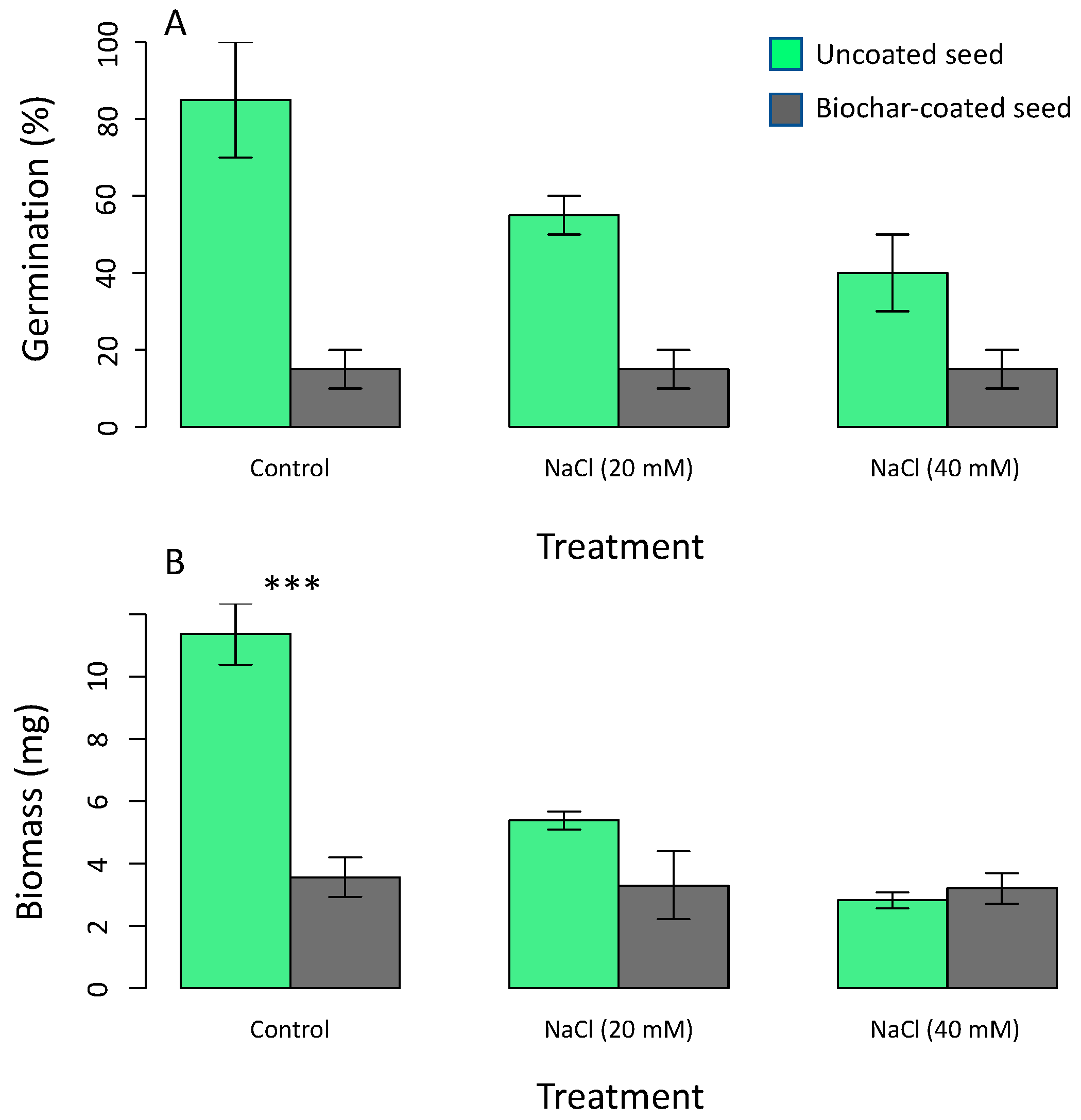
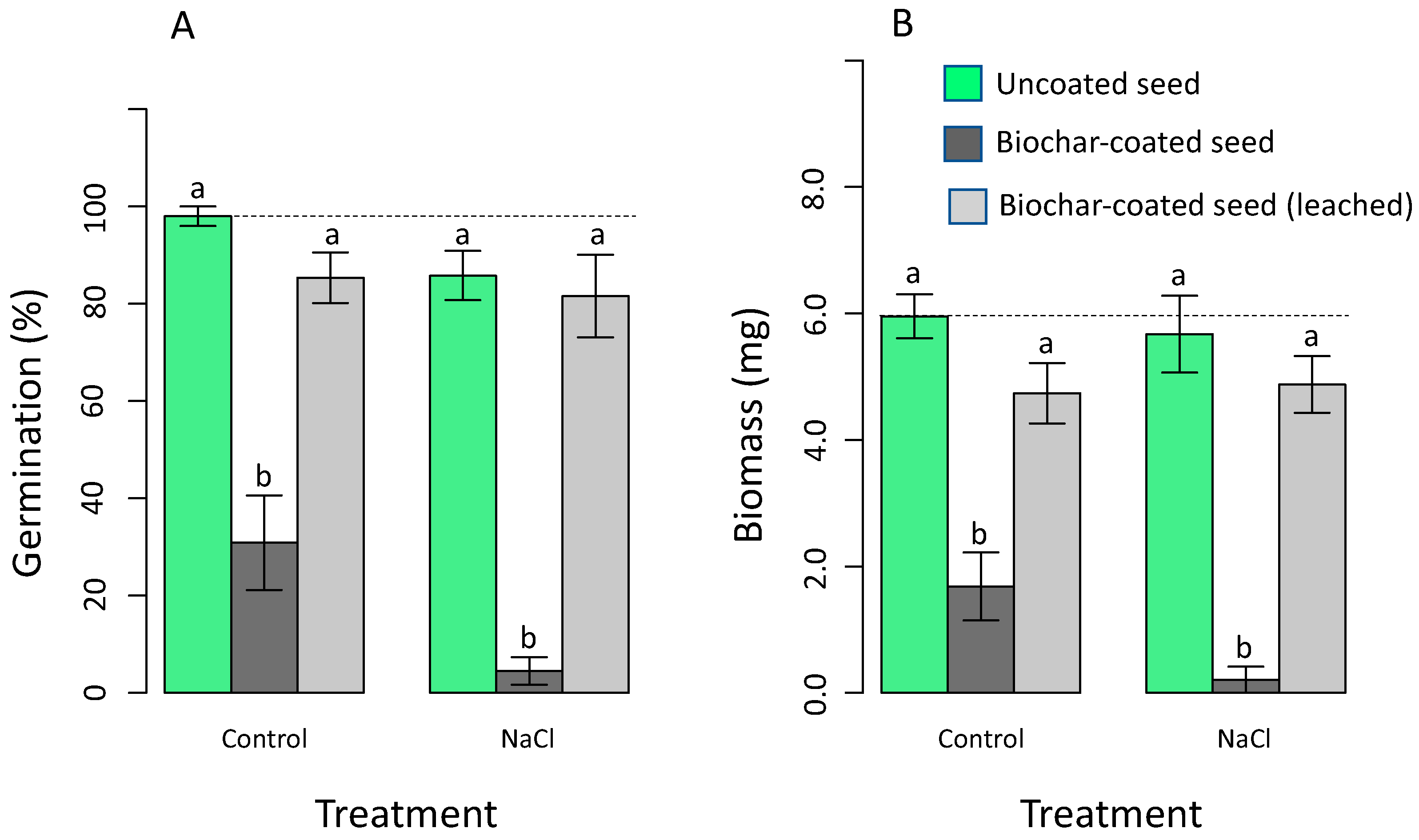
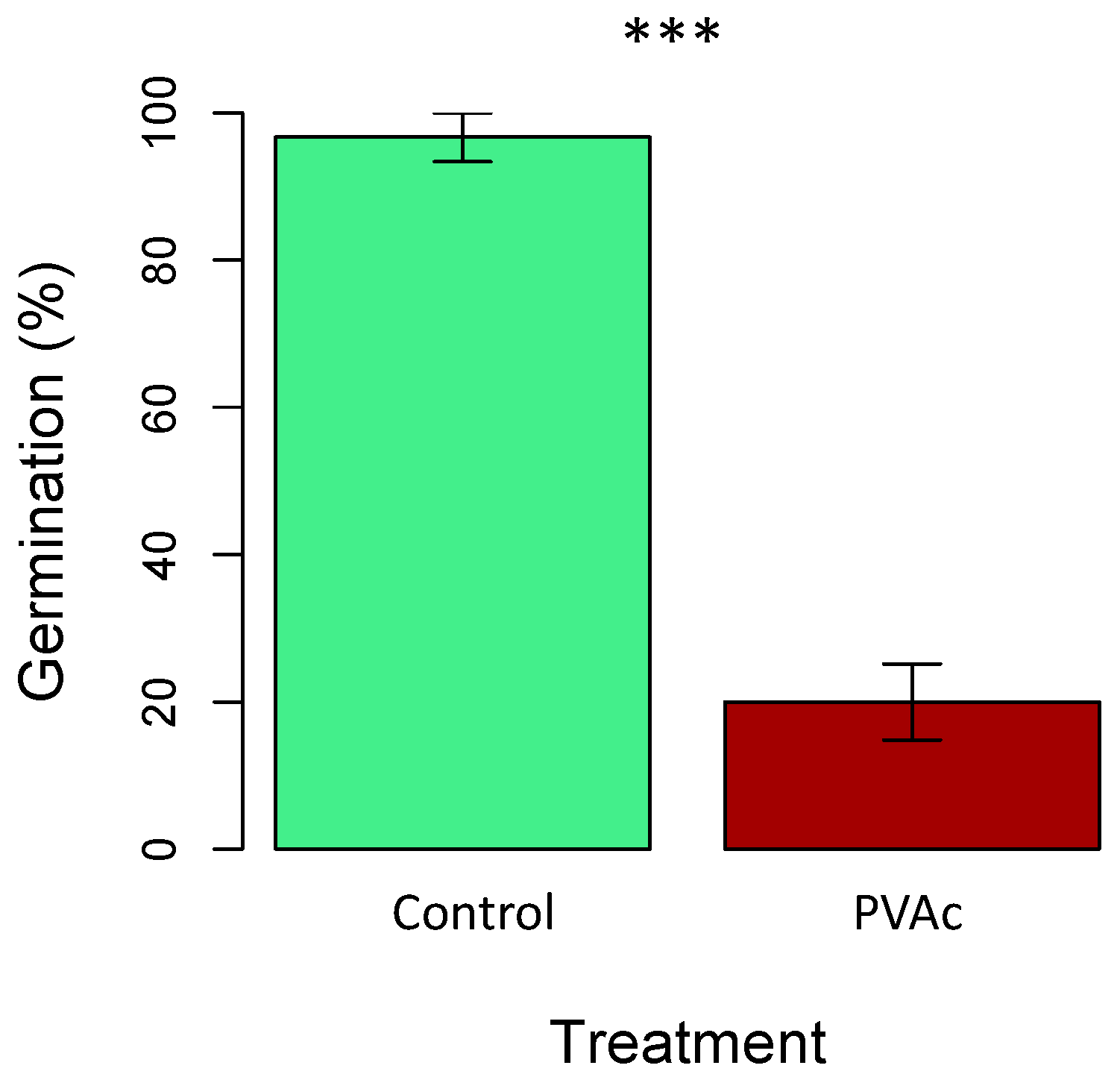
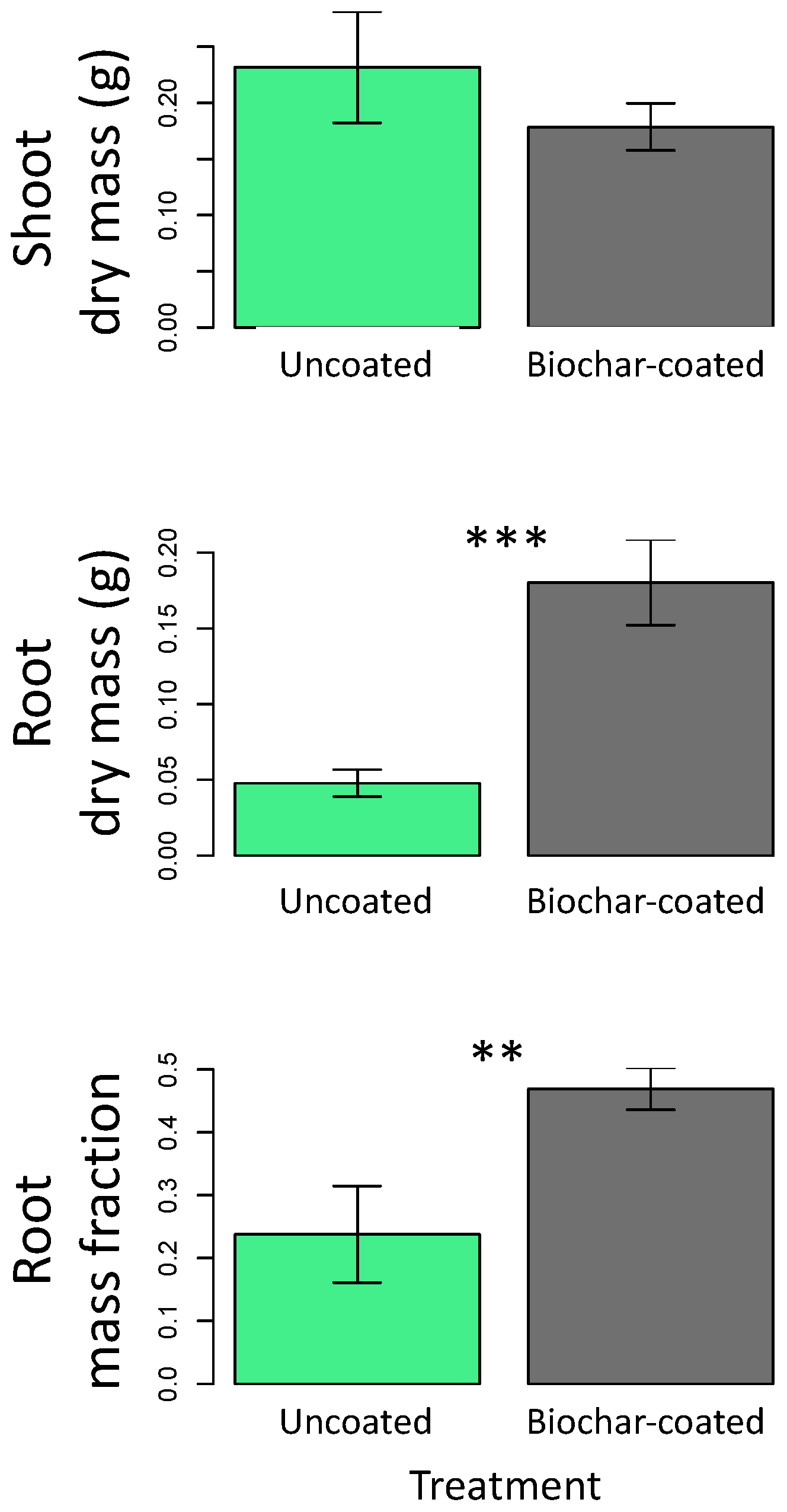
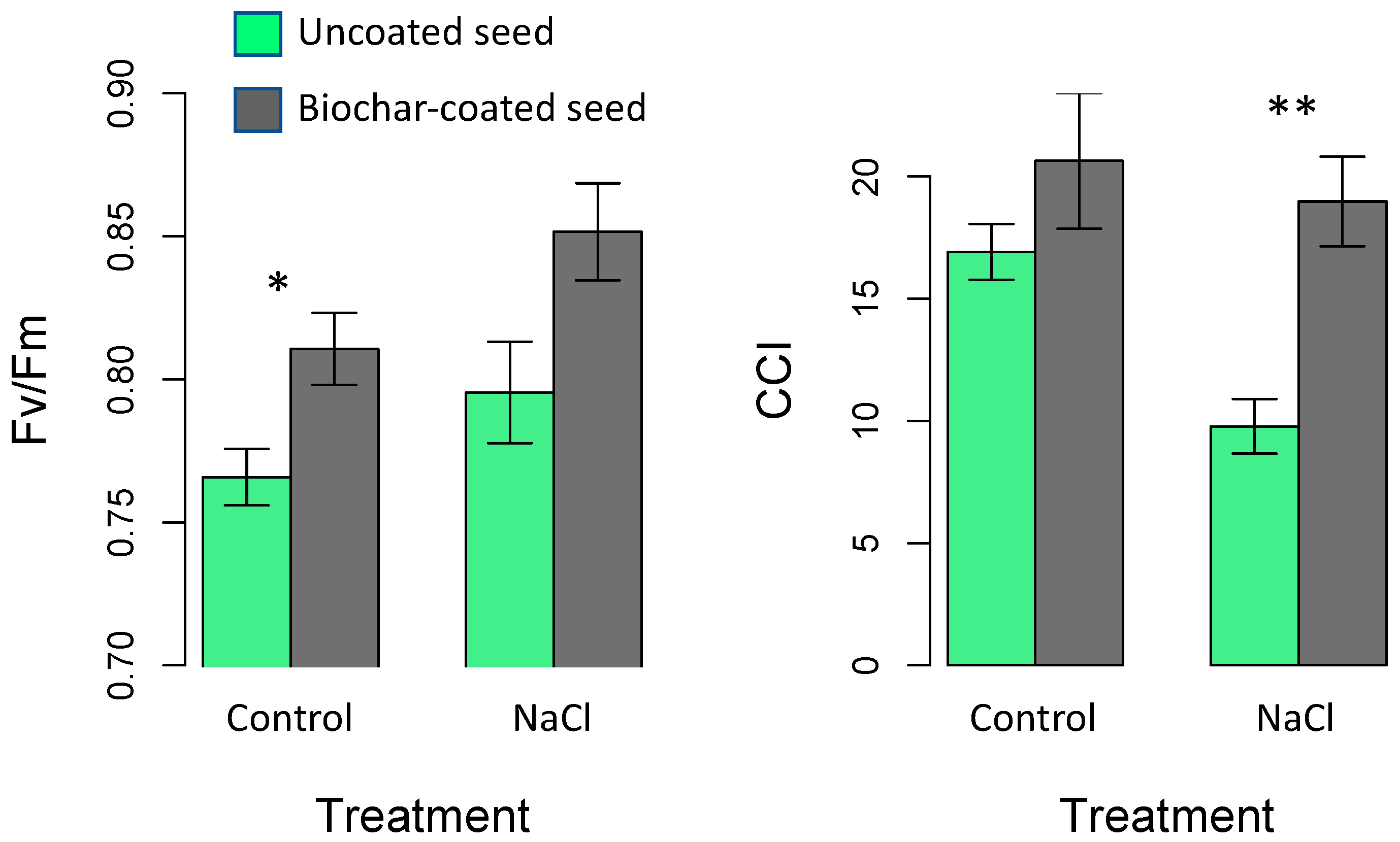
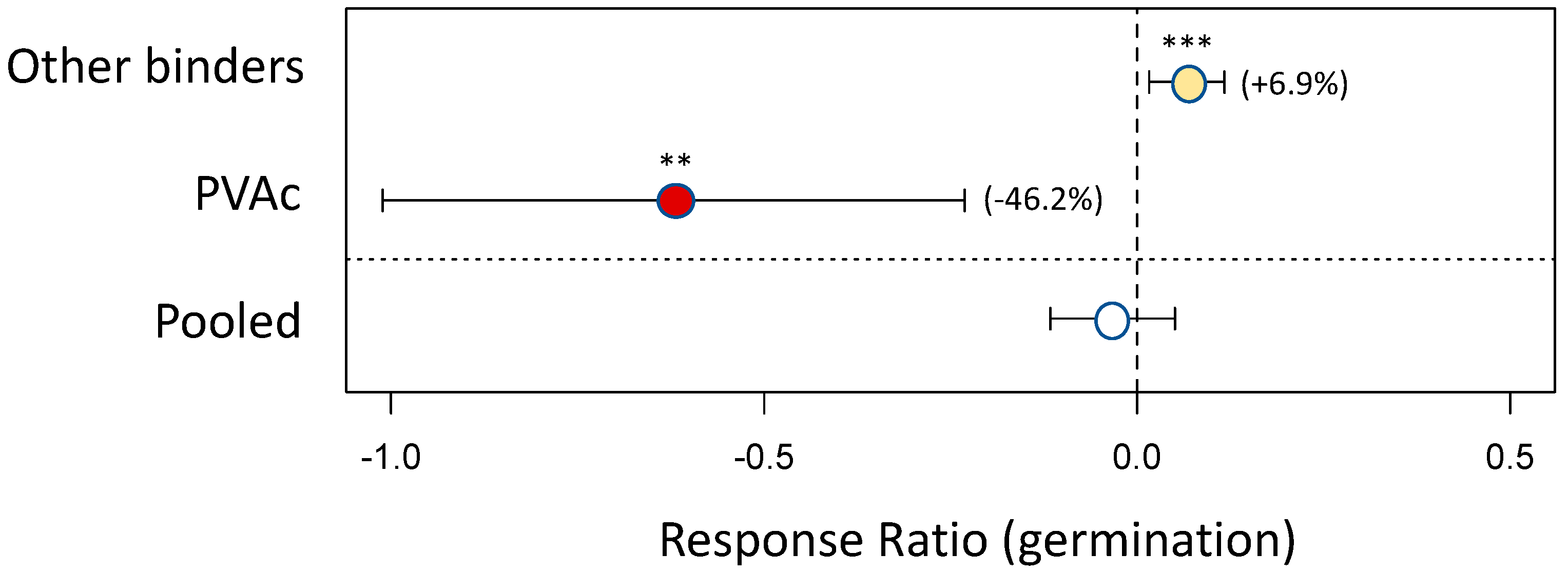
| Property | Value |
|---|---|
| Ash (%) | 11.4 (±0.2) |
| Bulk density (g cm−3) | 0.282 (±0.003) |
| Tap density (g cm−3) | 0.455 (±0.094) |
| pH | 10.2 (±0.03) |
| Electrical conductivity (µS cm−1) | 0.419 (±0.040) |
| C (%) | 77.2 (±1.8) |
| N (%) | 0.638 (±0.055) |
| P (%) | 0.0183 (±0.0005) |
| K (%) | 0.0533 (±0.0058) |
| Ca (%) | 0.597 (±0.015) |
| Mg (%) | 0.0667 (±0.0058) |
Disclaimer/Publisher’s Note: The statements, opinions and data contained in all publications are solely those of the individual author(s) and contributor(s) and not of MDPI and/or the editor(s). MDPI and/or the editor(s) disclaim responsibility for any injury to people or property resulting from any ideas, methods, instructions or products referred to in the content. |
© 2024 by the authors. Licensee MDPI, Basel, Switzerland. This article is an open access article distributed under the terms and conditions of the Creative Commons Attribution (CC BY) license (https://creativecommons.org/licenses/by/4.0/).
Share and Cite
Thomas, S.C.; Liu, Y.; Tang, E. Polyvinyl Acetate Binders Undermine the Effectiveness of Biochar-Based Seed Coatings. Land 2024, 13, 941. https://doi.org/10.3390/land13070941
Thomas SC, Liu Y, Tang E. Polyvinyl Acetate Binders Undermine the Effectiveness of Biochar-Based Seed Coatings. Land. 2024; 13(7):941. https://doi.org/10.3390/land13070941
Chicago/Turabian StyleThomas, Sean C., Yudong Liu, and Esther Tang. 2024. "Polyvinyl Acetate Binders Undermine the Effectiveness of Biochar-Based Seed Coatings" Land 13, no. 7: 941. https://doi.org/10.3390/land13070941
APA StyleThomas, S. C., Liu, Y., & Tang, E. (2024). Polyvinyl Acetate Binders Undermine the Effectiveness of Biochar-Based Seed Coatings. Land, 13(7), 941. https://doi.org/10.3390/land13070941








